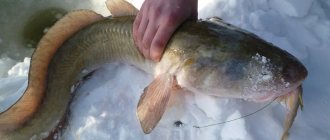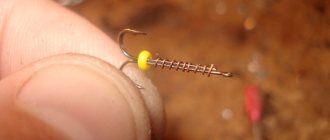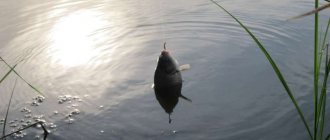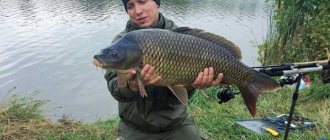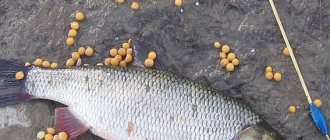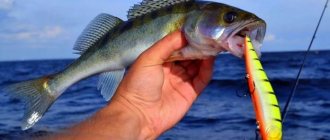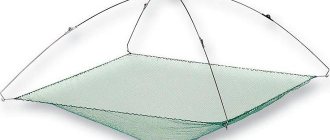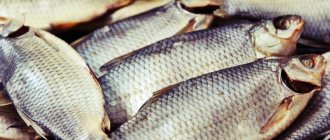Cod fishing is an exciting and profitable activity, as the catch can be very impressive. Cod has several main species (Atlantic, Pacific), as well as a number of local subspecies (Baltic, White Sea and others).
The length of large cod can reach one and a half meters and weigh up to 40 kg.
However, the objects most often caught are relatively small cod weighing 1-3 kg; trophies weighing 10-12 kg are less commonly caught. A wide variety of gear and baits are used for fishing, which we will discuss later.
If you want to get acquainted with other types of sea fish, we offer you articles about fishing for patus, flounder, and pelengas.
Where to catch cod
Atlantic cod is found in the northern waters of the Atlantic and partly in the waters of the Arctic Ocean.
This fish is actively caught in the Barents, Kara, Baltic seas, as well as in the Kola Bay.
Particular attention should be paid to fishing in Teriberka, which is located near the Barents Sea, where natural beauty, clean sea air and trophy fishing await you.
If you have a boat, searching for cod involves exploring coastal areas for the presence of underwater elevations, where schools of cod often swim.
Of course, sometimes fish are found at a depth of more than 100 m, but most often cod is caught at a depth of 30-80 m.
Cod can be classified as a coastal marine fish, so in winter there is no need to go far to sea.
Schools of cod often swim near sandbanks, where they feed on their favorite sandworm.
Cod fishing is best during daylight in early winter. Closer to February, the fish begin to gradually migrate to the Atlantic for the purpose of spawning.
Who are Trescoders? Fishing expedition to Teriberka
In just a few years, a forgotten village in the Murmansk region has turned into one of the most visited places in the Russian North. Some secular publications associate this with the release of Andrei Zvyagintsev’s film “Leviathan”, some of the episodes of which were filmed in Teriberka, but I personally am convinced that the true reasons for the popularity of the place are completely different...
In the dead of night we enter the Kola Peninsula. Both the weather and landscapes change immediately
I’ll say right away that the idea of traveling for the sake of sea fishing has never interested me enough to take at least some steps in this direction. Moreover, any conversation on this topic always somehow came down to Norway, which, in fact, has become synonymous with successful fishing for cod, halibut, sea bass, catfish and other predators. After all, whatever you say, the richest catches of skrej (especially large Atlantic cod) and halibut are possible only off the coast of the Norwegian fjords.
However, in the circles of Russian fishermen in recent years there has been a noticeable decline in interest in this Scandinavian country. The reason is simple and banal. Perhaps the main motivator of sea fishing is the opportunity to catch a lot, really a lot of very large fish. That is, such fishing satisfies two main requests of an experienced fisherman at once - quantity and size. Daily catches of several hundred kilograms are a common occurrence in these places and something completely fantastic for any body of water in central Russia. Those who went sea fishing could easily bring 100–200 kg of the cleanest, freshest and most delicious cod or halibut fillet. And individual specimens weighing 20, 30 and even 40 kg showed off in photos with satisfied fishermen.
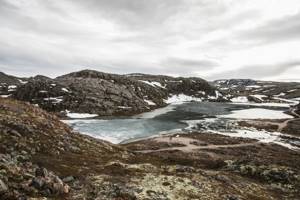
Glacial lake on a rocky plateau near Teriberka
But the idyll did not last long. After well-known political events in Russia, strict restrictions appeared on the import of fresh fish into its territory. In fact, today you can legally transport only 5 kg in vacuum packaging, and even then you may need documents confirming its origin. They may turn a blind eye to some insignificant amount, but it all depends on the customs shift and its mood. There has been no need to talk about any large-scale transportation for a long time - this has become very strict. Moreover, now the Norwegians have introduced their own restrictions, allowing the export of no more than 20 kg of seafood or one trophy (and the same halibut under 100 kg are caught from time to time). Here we must add significant costs and the language barrier, although the latter is the least of the problems, and there are bases that our compatriots own.
For some, the ban on leaving Norway put an end to Norway, and these are not necessarily some malicious alimony defaulters, but also those who cannot cross the border due to duty. In general, fishermen, having tasted the delights of sea fishing, began to look for alternative options. There is the Far East, where sea fishing is no less exciting and productive, but the key word in its name is distant. That is, long, far, expensive and impractical for the vast majority. But the alternative in the form of the Barents Sea turned out to be much more accessible and understandable to the widest circle of fishing enthusiasts. First, these places were scouted by veterans who were well acquainted with Norwegian fishing, and now those who had never left Russia also went.

The peculiarity of these places is strong ebbs and flows. During the day the water level changes by several meters
A few words about preparation
The limited organization services and the high demand for directions force us to start preparing for the trip long before it starts. For us, everything worked out spontaneously and very successfully: friends had already booked several hotel rooms, and the fishing itself was supposed to be a good test of the new boat in harsh conditions. Despite my wealth of experience, sea fishing is completely unique and unlike anything else - neither in terms of tackle nor equipment. Of course, a wide circle of acquaintances made it possible to avoid many mistakes, and the choice of gear for sea fishing is not as diverse as in any other direction. Now, having returned from Teriberka, I can more consciously recommend gear, and in all price categories.
First of all, in principle I wouldn’t start saving hard, but if I do it, it would only be on spinning rods. However, it is still advisable to have at least several of them. For example, in our large company, in just three days of fishing, four rods were broken for various reasons, and I had to share my stock of good WFT spinning rods. In fact, this is the only manufacturer on the Russian market focused on sea fishing. The peculiarity of choosing a spinning rod is in its test, that is, the weight range of the baits. If in normal fishing it rarely exceeds 30–40 grams, then in this case I used rods with a test weight of 200–1000 grams. And the average weight of baits is 400–600 grams.
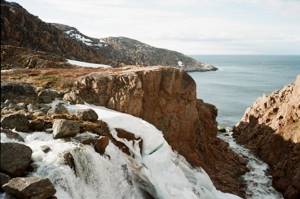
Fans of photo tourism and trekking will find a lot of interesting things here
With reels, the matter is even more serious, since intense fishing and heavy weights can immediately damage the budget versions. I had a pair of Penn Commanders, one of the more popular models, but quickly upgraded to better, more expensive ones. And the choice again fell on WFT, since the famous Shimano and Daiwa offer basically the same thing, but for absolutely crazy money. Of the good reels, I took one two-speed traction reel, very reliable and ready for any load, and one electric one. By the way, after Teriberka my opinion regarding this device completely changed. Before the trip, I thought that fishing with an electric reel was the lot of majors and physically weak people, whom I did not consider myself to be, but it turned out that this was far from the case.
As for baits, I took a small supply of several jigs - some were serial, and some were from St. Petersburg master Alexander, who not only often visits Teriberka himself, but also skillfully creates baits. It was his creations that brought the most bites. Another important detail is clothing. It is most comfortable to use a float suit: windproof, waterproof and allowing you to stay afloat if you find yourself overboard. In this part of the equipment, the choice is quite large, but this is a separate long conversation.
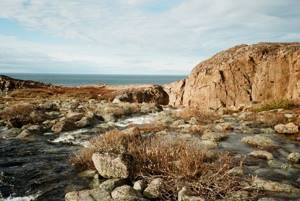
We had to fish in the open sea and make long passages. My boat is a rib (inflatable cylinders and a rigid hull) 4.6 meters long, of a special design. It is interesting that inflatable boats and fish are not very popular and rare in Norway, whereas in Russia they make up 90% of the fishing fleet. Stability and low sides, good seaworthiness and safety are the main reasons for choosing this class. However, there are a couple of fly in the ointment. Fishing takes place using huge tees, and large fish are most often lifted using a sharp hook, which means the chances of breaking through a PVC balloon increase. And this actually happens sometimes, although fishermen try to be extremely careful. As I already said, my rib has a special design - the inside of its body is made of plastic, therefore, it is impossible to break through the cylinders from the inside. 30 hp motor This is quite sufficient for a boat of this size and allows you to save significantly on gasoline. In general, we attach all this equipment to our Skoda Kodiaq and hit the road.
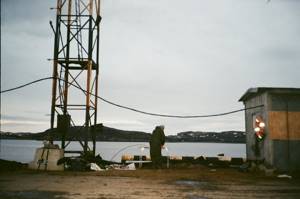
A mandatory evening ritual is to clean, or as the locals say, “skin” the fish
Route "Kola" - fishing route
Of all the roads coming from St. Petersburg, the Murmanskoye Highway (Kola Highway) is the main road artery for fishermen. It leads to the very north of the country, crossing the Republic of Karelia and the main fishing grounds of the Leningrad region, so along the way we always meet many fellow fishermen with boats on trailers. Ahead of us we have 1,400 kilometers of quite good and smooth road. If your boat is not huge and does not require a lot of weight and power to tow a car, then a crossover is the best choice. It successfully combines towing capacity and fuel efficiency. And considering that on some stretches of 100–150 km you may not find a single gas station, this parameter becomes decisive.
But we know the route well, and all stops are planned in advance. Of course, it is better to make such trips with several crews. In our case, the team consisted of five boats, but three left a little earlier, and we were accompanied by friends with almost the same boat (Fortis Z) and also in a Skoda. Of course, a diesel engine would be a better choice in such a situation, but even with a gasoline engine, consumption did not exceed 12 liters per 100 km. And this takes into account the boat on a trailer, filled to the brim with things and fuel, as well as four people in the cabin. I must say, the final stretch of the journey is truly impressive! Snow, strong winds, bumpy dirt roads and a complete lack of vegetation - this is the truly harsh Russian North. Having left St. Petersburg at around 13.00, with stops, refueling and a segment with repair work, we arrived at the site by 7 am. Although at this time of year there is a polar day and it is light all day long.
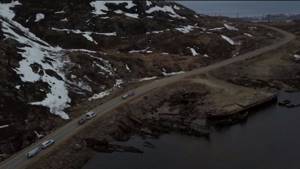
Accommodation at the base
Service, infrastructure, hotels - all these concepts are not applicable to the numerous backwaters of our huge country. However, not so long ago several places were opened in Teriberka where you can stay comfortably. In our case, it was a hotel converted from a former fish factory. Rooms for 2, 4 and 5 people. The room has a shower and modern furniture. Only the kitchen and drying room are shared. There is a boat slip nearby; boats can be taken ashore or left on the water. The main thing is to watch the tides so that they are not left lying on the rocks at low tide. In addition, there is a store, a place for cutting fish and a large freezer. All this pleasantly surprised us!
One of the important aspects is quite strict adherence to the rules for going out on the water. The boat must be registered and the captain must have a license. After receiving permission, it is necessary to notify the border control two hours before leaving, then once again upon actually leaving, and definitely upon returning to the shore. This can be done both by marine radio and by mobile phone. By the way, communication in Teriberka works. Border guards and GIMS representatives on shore can check the availability of life jackets and documents, as well as the catch upon return. And there is a nuance here. According to the rules, up to 100 kg of fish per person per day is allowed, but no one strictly monitors this. Another thing is Kamchatka crab. Without exaggeration, this infection was brought to the Barents Sea during Soviet times. The crab has taken root and is doing great, but for some unknown reason, catching it is not only prohibited, but also criminally punishable. So, if you suddenly get caught (which happens often!), it is better to send it back immediately. To the bottom.

About the Barents Sea
The Barents Sea belongs to the Arctic Ocean basin. Its waters wash the shores of two countries - Russia and Norway, as well as three archipelagos - Franz Josef Land, Novaya Zemlya and Spitsbergen. Thanks to the influence of the Gulf Stream, the sea here not only does not freeze in winter, but is also rich in all kinds of marine life - from fish and other seafood to dolphins, whales, killer whales and fur seals. It has always played an important transport role and was of great importance for industrial fishing. The Barents Sea is not very deep, its maximum depth does not exceed 600 m, the average – 300–400 m, and in fishing areas – 40–130 m.
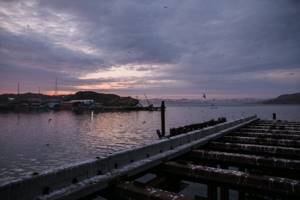
First trip to sea
On the very first day we went in search of fishing luck. It is clear that fish in the sea are constantly moving, but there are places where the likelihood of rich catches at a particular time is very high. Although even there you need to look for it in a fairly large area of water. Local fishermen usually exchange information about places of successful catches - there is enough fish for everyone. There are two areas where the chances are especially great - Kildin Island and the village of Dalnie Zelentsy. They are located almost at an equal distance, 40–50 km from Teriberka, but in opposite directions. We didn’t dare make such a long trek on the first day and stopped about fifteen kilometers from the base.
The first thing that unsettled me was the waves 2.5–3 meters high. At some moments you see only a wall of water in front of you, and in such conditions you still need to fish. I had barely turned off the engine when a dolphin appeared a few meters from the boat. There are plenty of them here, but from a fishing point of view this is not a good sign - the dolphins quickly scare away the fish. In general, the first trip to sea was not very successful. On each of our five boats, someone got seasick and, as we later learned, no pills or folk remedies help. A few moves of the bait, a couple of bites - and it became clear that we needed to return. That night I fell into perhaps the deepest sleep of my life.

The vicissitudes of the weather
The weather is capricious and changeable everywhere, and especially here in the north. Only one thing is constant - the winds. When their gusts exceed 10 m/s, fishing becomes not only uncomfortable, but also dangerous. If the wind blows from the ocean, the waves can easily reach 4–6 meters, which looks very scary for an unprepared person. Here, by the way, a mobile fish has advantages over a large boat. The width of the wave reaches 15 meters, and in general you feel the amplitude of the vibrations, but without hard impacts - the rolling on large boats and fishing schooners is felt much more acutely. A strong wind (up to 17 m/s) left no hope of getting out, and we began to look for other entertainment.
The village itself, of course, is not at all like Ibiza: a gloomy picture and complete devastation. Its main attraction is a pile of iron that was once ships. The name is appropriate - Ship Graveyard. Another thing is nature. In addition to fishing enthusiasts, these regions attract fans of landscape photography and ecotourism. Magnificent views of the bays, steep cliffs and powerful waterfall. In short, if you don’t go to sea, there is something to do and see.

A rematch
Finally, the weather stabilized, and early in the morning we went to sea, not forgetting to warn the border guards. Of the two possible directions, we chose the eastern one - to Far Zelentsy. Probably because the name is almost native to us, because on Zelentsy Lake Ladoga we catch perch every year. It was completely calm, although a wave of about two meters was still walking across the expanses of the Barents Sea. The transition took about an hour, and two dozen already “parked” boats showed us the right place. The search for fish began, and I realized that it was not in vain that I took an electric reel, because frequent changes of location require lifting the gear, and pulling a 600-gram jig from a 100-meter depth is quite an exercise! The first bite was not long in coming, but there was no need to talk about a crazy bite. Either the fish were not active or they were not in this place. We continued the search, now moving towards the shore, now moving away from it.
At some point, characteristic fountains appeared to the side of the boats. Whales! At first we thought that this was a small family, but it soon turned out that there were at least a dozen of them. An absolutely fantastic picture from National Geographic. You sit in a boat, and these giants circle around, making unusual sounds, exhaling air and rising to the surface. We lower the tackle - and immediately there is a powerful bite. Then again and again... Fish found! Cod is not very large - 2-4 kg, but it resists many times more than any freshwater fish. Even with an electric reel you have to fight, but what happens if a real trophy bites? For the first time in many years, I felt real excitement and forever changed my attitude towards sea fishing.
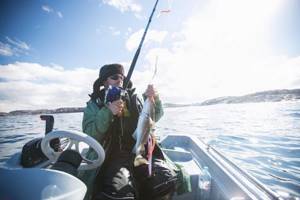
At some point the jig got caught on the bottom, this happens sometimes. We start the engine to go around on the other side, but the cord winds up much faster than we drift, gradually rising to the surface. It soon becomes clear that this is a whale. I don’t know how he grabbed the bait, perhaps it caught on to him. Obviously, there is no point in fighting in such a situation, but it was necessary to save the cord. To do this, we began to chase the whale, but nothing came of this venture either. When the counter showed that my trophy had already reeled in almost 200 meters of cord, I simply cut it. So I was left without an electric coil.
After some time there was a powerful bite again. Meanwhile, the partners on the next boat lift the cod by 11 kg! There are many boats and even ships gathering around - everyone is catching! In addition to cod, from time to time you come across haddock; on another boat they take decent catfish, halibut and that same crab. By four o'clock there is no more strength left. The whole boat is covered with the catch. It is worth noting here that releasing fish raised from 50–100 meters makes little sense. They say that only halibut can withstand such overloads, all others are doomed.
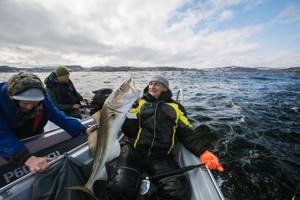
On the shore it turned out that our catch that day was one of the most modest. Although, it should be noted that most of the time I fished alone (my partner had no time for fishing again due to the motion), while others fished with 2-3 spinning rods. We didn’t weigh the fish, but it turned out to be about 150 kg. Fantastic! But some people even had about 300. Perhaps, such fishing requires intensive training in the gym. Another important ritual is cleaning the fish. Some people do it right on the water, but we spent the whole evening cutting up the catch. Dinner, discussions, getting ready - and in the morning our team sets off on the return journey with thoughts of conquering new spaces. Now sea fishing will take pride of place on the mandatory list of my hobbies.

Text and photographs by Dmitry Matveev
#club4x4 #4x4club #magazine4x4 #4×4magazine
Baits and lures for cod fishing
The bait used is chopped pieces of fish, mussel meat and various shellfish, as well as the above-mentioned sandworm.
For example, cod is successfully caught using eelpout meat. Pieces of meat stick well to the hook; sometimes you can catch two cod at once with one hook.
It is more difficult to attach shellfish meat to a hook, which is why this bait is used only for vertical fishing.
You can also catch cod using the meat of the cod itself (on itself). Cod bite especially well on the intestines of their own kind, and such bait stays quite firmly on the hook.
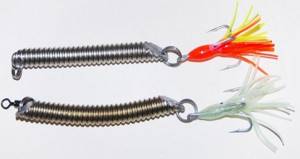
Among artificial baits, spinners with tees are widely used. These can be either branded products from stores or homemade baits, mainly spinners. As for the color of spinners, the most suitable colors are lemon and orange. Unique luminous spoons are considered catchable.
Fishing for cod with a jig
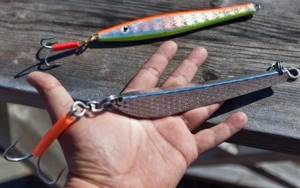
A jig weighing 200-300 g acts as the main bait, while above it on the garter a kind of garland rig with 3-4 hooks is used. Ordinary twisters can also be attached to the hooks. Garters are made from shiny synthetic threads.
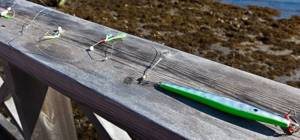
There is no clear assessment of the importance of jig shape and color among fishermen. Some do not pay much attention to these characteristics, while others believe that the number of bites largely depends on the type and color of the bait. Therefore, you can safely experiment and try different jigs.
Cod fishing gear
To catch cod, you don’t need an expensive rod from the latest series; an average fiberglass model is quite enough. The upper test value must exceed the 200 g mark, the optimal length of the rod for fishing from a boat is 1.8-2.3 m.
If you use monofilament fishing line, then its diameter should be in the range of 0.5-0.7 mm.
Also, recently, braids with a diameter of 0.3-0.4 mm have often been used, which, when fishing at great depths, demonstrate better sensitivity in case of bites.
In addition to a strong fishing rod, you will also need a powerful reel that will not let you down at the crucial moment. For sea fishing, proven multiplier models are used that are not afraid of the effects of salt water.
Reels that are not intended for sea fishing rust after just a few fishing trips, which is why they constantly need to be lubricated.
It is also desirable to have such a useful device as a hook in the auxiliary fishing arsenal. A landing net is not very appropriate, because hooks will often get caught in its net, but a hook with a long handle will be very helpful when pulling out heavy cod.

Sea fishing on the Barents Sea
How to get to the fishing spot:
The most convenient and cheapest way to get to Teriberka is by car. To make it profitable and comfortable for you on the road, there must be three people in the car (two drivers are required).
Why exactly three people and at least two drivers in the car? This number of people allows you to comfortably get to Teriberka, without long stops. One driver drives the car, the second one takes a nap lying in the back seat, and the third participant provides backup. *These are our recommendations based on experience, you make your own decision about the trip. You can go alone, but will it be safe? And you will have to pay for all the gasoline yourself. You shouldn’t put passengers in all the seats, you will deprive people of comfort and you most likely will not have enough trunk space for things and loading fish on the way back.
How many kilometers to Teriberka? — from Vyborg 1550 km. — from St. Petersburg 1400 km. — 2000 km from Moscow.
How long does it take to get to the fishing spot? — the road from St. Petersburg usually takes 18-26 hours, depending on road conditions, snacks, stops for photography, rest.
How much does it cost to buy gasoline? — on average, a round trip for gasoline costs 15,000 rubles. to the car.
If I don’t have a car or don’t want to drive my own, how can I get to Teriberki? There are several options: - if there are free seats in the cars of other participants and the owner wishes, they can take you with them. — encourage friends who have a car to travel. — buy a plane or train ticket to Murmansk, so as to be in time for the exit to the sea, order a transfer to Teriberka. In this option, there are disadvantages: due to weather conditions, the road may be closed, then there is a high probability of being late to Murmansk at the right time. And an interesting question arises: how to bring the caught fish?
Tackle for sea fishing on the Barents Sea in Teriberka.
A reminder for those who want to buy equipment for sea fishing. This article contains purely personal recommendations based on many years of experience. We'll tell you what gear we use and explain why.
What does sea fishing gear consist of? Spinning rod, sea reel, braided cord, equipment - single hooks, carabiners, rings, punda with tee.
Spinning rod for sea fishing in the Barents Sea. The length of the spinning rod must be no less than 1.6 meters and no more than 2.1 meters with a dough weight of 300 to 1000 grams. With a large test, you can drag the fish without fear that something will break, but the pleasure of fishing is proportionally reduced by the test. But with a small dough the opposite is true. The rod is very sensitive, every jerk is felt, but you need to be careful with sudden movements, the spinning rod may not withstand excessive jerks. The longer the rod, the more jerking the fish is felt, with a long rod it is not very convenient on the boat, it will get in the way everywhere, it is more difficult to untangle, and it is more difficult to lift the fish on board. You need to find a middle ground for yourself; there is no ideal option.
There are two options for spinning rods with rings or rollers. Each has its own pros and cons
Pros and cons of spinning rods with rollers: The main advantage of rollers is that they withstand impacts and throwing of the spinning rod very well, and this very often happens on an iron vessel when pulling out fish. It is believed that a spinning rod with rollers rubs the braid less. The downside is that sometimes the cord jumps off the rollers and gets stuck; you definitely need to keep an eye on this. Sea rod Mystic Heavy Pilk 59EH (175 cm, 500-1000g)

Sea fishing rod Surf Master Commander with rollers 1.65m (300-700gr)
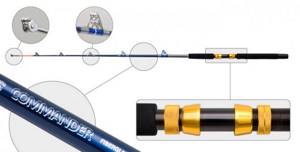
Pros and cons of a spinning rod with rings: Silent and lightweight, rarely seen with large dough and short length. Very often, inserts in rings fly out and break during transportation and fishing. You should always carefully place the spinning rod on the deck. Sea rod Maximus Deep Hunter 210H
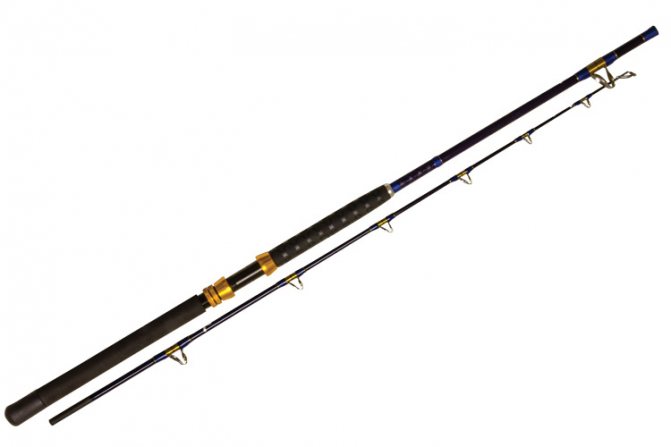
Recommendations: — immediately after each fishing, be sure to disassemble the spinning rod and wash it in fresh water. — The end of the handle must be equipped with an axial rotation locking cross. — The thicker the handle, the more comfortable it is. — It is desirable to have an aluminum ring for attaching the coil.
Marine reel. The best reel in terms of price-quality-reliability ratio is Penn Comander pro 30 . For many years the reel has not failed.
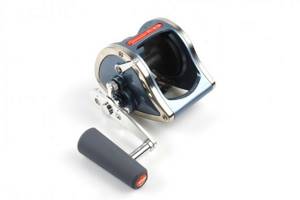
Recommendations: - be sure to lubricate the mechanisms after each fishing season - The more bearings the reel has, the better. — A thick handle is more comfortable — The more bearings the reel has, the better. — Mandatory presence of a line layer. — The reel must hold at least 250 meters of braided fishing line with a diameter of 0.4 - 0.8 mm.
Cord Braided cord should be selected with a diameter of 0.4 to 0.8 mm. The breaking load must be at least 30 kg. The fishing line is not suitable for sea fishing, since it stretches during sharp swings of the rod, and the equipment practically does not move at depth. Recommendations: - Take a cord with a color change every 10 meters. You can easily determine the depth and level of reeling of the bait. — The most common cord diameter is 0.5 mm. with a breaking load of at least 45 kg. — Use special knots for the cord
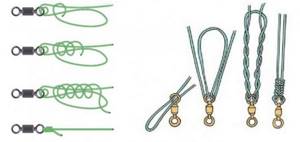
— It’s better to buy a winding of 300 meters. — The cord is a consumable item, there is no point in buying very expensive ones.
Equipment The equipment consists of a spoon and one or two single hooks. We use “pondas” with a tee and no more than two hooks in the suspension. “Pundas” have a relatively large weight - from 500 grams. up to 1 kg. The most optimal weight is 700 grams. This weight is necessary for the “punda” to sink to the bottom as quickly and smoothly as possible without interfering with other fishermen; very often in the Teriberka area there are strong undercurrents, light tackle will be carried away and you will constantly get confused with your partners. The size of “Punda” is from 15 to 30 cm, this is the approximate size of capelin, herring and juvenile cod. We recommend making “Pundas” yourself from stainless steel pipes and filling them with lead; it will be much cheaper than store-bought ones. “Punda” is equipped with a large, strong tee no less than No. 12. The larger the hook, the easier it is to pull it out of the fish’s mouth. You can attach a red cambric to the tee. The tackle is equipped with a suspension, one or two single hooks with red cambrics of at least size No. 10, tied to the main cord on short leashes at a distance of 50-80 cm from each other above the “punda”. The tackle should look like this: Cord, swivel, carabiner, rig with two hooks, carabiner, swivel ring, punda, ring, swivel, ring, tee Recommendations: - do not buy cheap and Chinese accessories, everything breaks and bends.
How to catch? Fishing takes place using vertical lures. At the captain’s signal, the tackle is lowered to a depth, usually 1–2 meters from the bottom. Next, you need to jerk the spinning rod sharply and rhythmically. The amplitude of the strokes should be 1-2 meters. During the flashing process, we change the speed, amplitude, and try different options. When changing the fishing location, the captain gives a signal and everyone lifts the gear on board.
What time do we start and finish fishing?
Since ancient times, Teriberka has been considered the most profitable place for sea fishing due to its proximity to the open sea. Capelin comes here to spawn, and this is a delicacy for cod. And the cod itself spawns here. From March to June, huge schools of fish gather in the Teriberka area and it is easy to catch them at depths from 20 to 120 meters.
07:30 - 08:00 from the port of Teriberka - Boarding the boat - Checking documents by border guards - Departure of the vessel
Transfer to the fishing place: Dolgaya Bay - 40 minutes, Teribersky Cape - 1 hour, Opasovo Bay - 1.5 hours, about. Kildin – 3 hours
At the request of guests, to prepare fish soup or other delicacies, you can hide from the excitement in the nearest lip. There you can fish in a calm atmosphere and clean the deck. At sea, as a rule, we don’t cook food, it’s rocky.
In the event of stormy weather, force majeure, or MORF exercises, the captain independently decides to stop fishing and proceeds to the port.
18:00-20:00 Arrival in Teriberka
— Checking the catch by a fish inspector — Unloading the catch
